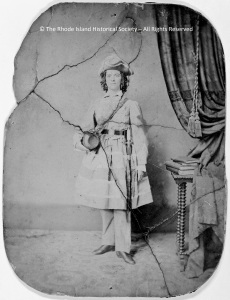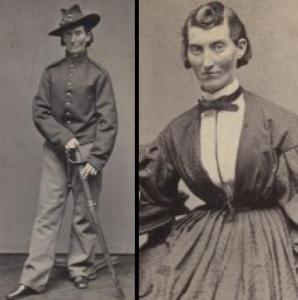Kady Brownell may be our most famous Rhode Island woman that disguised herself as a man to fight in the Civil War but there are others, from Rhode Island and other states, who did the same.
Kady Brownell (1842 – January 5, 1915) was a vivandière (French name for women attached to military regiments as sutlers or canteen keepers) who helped the Union army during the American Civil War. She went with her husband when he joined a Rhode Island regiment. Brownell trained with the soldiers. She fought in battle and helped the injured. At the First Battle of Bull Run, she held the flag high even as Confederate bullets were flying.
Kady Brownell was born in 1842 in a tent on a British army camp in Kaffraria, South Africa of a French mother and Scottish father. Her father, Col. George Southwell, was on maneuvers at the time. She was named after her father’s friend, Sir James Kady. Her frail mother died shortly after her birth. She was adopted and raised by a couple until they immigrated to Providence, Rhode Island, where she was then raised by family and friends. In the early 1860s, Kady worked as a weaver in the mills of Providence, where she met and fell in love with Robert Brownell and married him in April 1861.
With the outbreak of the Civil War in April 1861, Robert joined the 1st Rhode Island Infantry. Brownell was determined to serve with him. She approached Governor Sprague who agreed to take her along to Washington and there met up with Robert. Colonel Ambrose Burnside, the regiment’s commander, appointed her a Daughter of the Regiment and color bearer. She was an active participant in the First Battle of Bull Run (1861), and after re-enlisting into the 5th Rhode Island Infantry with her husband Robert Brownell, at the Battle of New Bern (1862). Brownell remained in New Bern after the battle, aiding her injured husband. Upon his recovery, he was deemed unfit for battle, and not wanting to fight without her husband, both Brownells were discharged.
Following the Civil War, Brownell was the only female to receive discharge papers from the Union Army. In September 1870, she became a member of Elias Howe Jr. Post #3 of the Grand Army of the Republic in Bridgeport, Connecticut. She applied for a pension in 1882, and received her $8.00 per month allotment starting in 1884, compared to her husband’s pension of $24.00 a month.
Brownell died on January 5th, 1915 at the Women’s Relief Corps home in Oxford, New York. A funeral service was held for her in New York City on January 7, then her body was shipped to Providence by steamboat for a second funeral service. She is buried in Providence’s North Burial Ground.
However, her husband is buried in an unmarked grave site in East Harrisburg Cemetery, in Pennsylvania.

Juliana Parker Monroe (1832 – November 7, 1905) was another Rhode Island woman who accompanied her husband while he served in a Rhode Island unit during the war. Julianna was born in Scituate, Rhode Island. She married her first husband (name unknown, possibly a Round) and went to war with him. She was adopted as a “Daughter of the Regiment” and had her picture taken in uniform. She is listed on the 1885 Census as “divorced” and “daughter” living in Scituate. Julianna married George W. Monroe on December 16, 1892 and died in Providence on November 7, 1905.

Deborah Sampson Gannett (December 17, 1760 – April 29, 1827), better known as Deborah Samson or Deborah Sampson, was a Massachusetts woman who disguised herself as a man in order to serve in the Continental Army during the American Revolutionary War. She is one of a small number of women with a documented record of military combat experience in that war. She served 17 months in the army under the name “Robert Shirtliff” (also spelled in various sources as Shirtliffe and Shurtleff) of Uxbridge, Massachusetts, was wounded in 1782, and was honorably discharged at West Point, New York in 1783.

Frances Louisa Clayton (c. 1830 – after 1863), also recorded as Frances Clalin, was an American woman who disguised herself as a man to fight for the Union Army in the American Civil War. Under the alias Jack Williams, she enlisted in a Missouri regiment along with her husband, and fought in several battles. She left the army soon after her husband died at Stones River. Newspaper reports indicate that Clayton served in both cavalry and artillery units. Her story became known and widely circulated after her service, though each account contains contradictory information about her life and service. Several photographs of Clayton, including images of her in uniform, are known to exist. However, little else is known of her life.

Pauline Cushman (born Harriet Wood; June 10, 1833 – December 2, 1893) was an American actress and a spy for the Union Army during the American Civil War. She is considered one of the most successful Civil War spies.
After a Northern performance, Cushman was paid by two local pro-Confederate men to toast Confederate President Jefferson Davis after a performance. The theatre forced her to quit, but she had other ideas. She had decided to ingratiate herself with the rebels by making the toast, while offering her services to the Union as a spy.
By fraternizing with rebel military commanders, she managed to conceal battle plans and drawings in her shoes, but was caught twice in 1864 and brought before Confederate General Braxton Bragg, tried by a military court, and sentenced to death by hanging. Though she was already ill, she acted worse off than she was. The Confederates had to postpone her execution. Cushman was spared hanging by the invasion of the area by Union troops. She was also wounded twice.
Some reports state that she returned to the South in her role as a spy, dressed in male uniform. She was awarded the rank of brevet major by General James A. Garfield, and made an honorary major by President Abraham Lincoln for her service to the Federal cause, and became known as “Miss Major Pauline Cushman.”By the end of the war in 1865, she was touring the country giving lectures on her exploits as a spy.
For more information on these amazing women follow the links below!
https://en.wikipedia.org/wiki/Kady_Brownell
https://en.wikipedia.org/wiki/Deborah_Sampson
https://en.wikipedia.org/wiki/Frances_Clayton
https://en.wikipedia.org/wiki/Pauline_Cushman
http://www.burnpit.us/2017/01/death-kady-brownell-first-woman-member-grand-army-republic-veteran-war-between-states
https://americancivilwar.com/women/pauline_cushman.html
https://www.civilwar.org/learn/articles/female-soldiers-civil-war
Jennifer L. Galpern, Special Collections Research Associate
